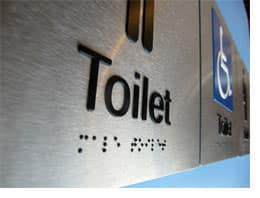
When auditing a sign, the following are the key items are checked.
* It is our opinion this requirement is flawed as Arial typeface is copyright and under it’s usage license cannot be modified. In addition having lower case letters that are smaller than standard creates an issue with the weights of the lower case letters.
** The semi circular Braille should not be used when a single line of Braille is used. This is covered both within the BCA & AS1428.1-2009.
AS 1428.1—2009
NOTES:
1 The Braille indicator is only used where there are multiple lines of text. It indicates the location of the first line of Braille.
BCA D3.6 part 6
(f) On signs with multiple lines of text and characters, a semicircular braille locator at the left margin must be horizontally aligned with the first line of braille text.
The physical specifications for Braille dots and the distance between them shall be as follows:
Note I: within cells the horizontal distance between dots must always be less than or equal to the vertical distance between them.
Note II: Braille dots should be smooth and pleasant to touch. Therefore, dots must be dome shaped, rather than being pointy or flat. Note that the spherical radius is a function of the base diameter and the height of dots, not an independent parameter.